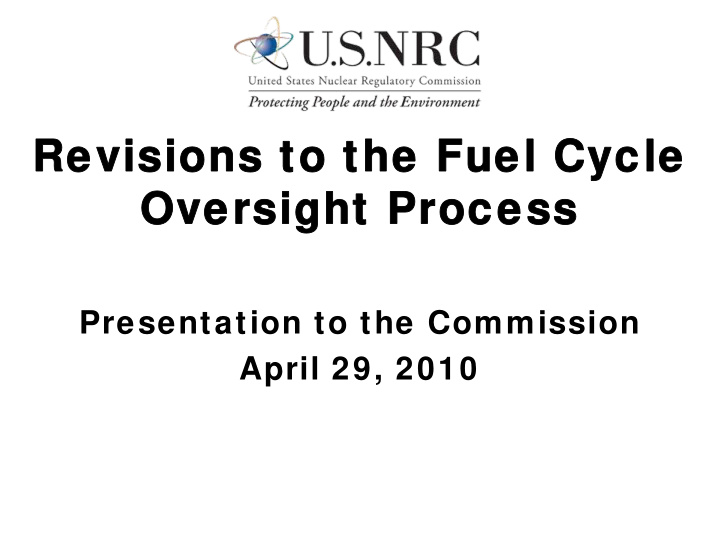



Revisions to the Fuel Cycle Revisions to the Fuel Cycle Oversight Process Oversight Process Presentation to the Commission April 29, 2010
Agenda Agenda • Current Process– Joe Shea Director DFFI, Region II • Proposed Revisions – Dan Dorman Director FCSS, NMSS 2
Overview of the Current Fuel Overview of the Current Fuel Cycle Oversight Process Cycle Oversight Process • Oversight Process Elements – Inspection – Enforcement – Assessment • Implementation 3
Overview of the Current Fuel Overview of the Current Fuel Cycle Oversight Process Cycle Oversight Process (Cont.) (Cont.) • Current program is adequate to ensure safety and security • Current program is evolving, slow ly, w ithin existing framew ork • Approach to improvements can be better focused, more effective and efficient 4
Purpose of Oversight Revision Purpose of Oversight Revision Project Project • To improve program effectiveness and efficiency • To make the process more – Risk-Informed – Performance-Based – Predictable – Transparent 5
Risk Informed & Performance Risk Informed & Performance Based– Current Program Based– Current Program • Inspection – Use of Integrated Safety Analyses (ISA) during inspection planning improves risk focus – Programmatic approach still used in some areas • Enforcement – Proposed policy is more ISA-informed 6
Risk Informed & Performance Risk Informed & Performance Based– Current Program Based– Current Program • Assessment – Process allow s for integration of enforcement actions – Some consideration of risk 7
Predictability – Current Predictability – Current Program Program • Inspection – Reactive and initiative inspection decisions lack clear thresholds • Enforcement – Variability in ISA methods presents a challenge 8
Predictability – Current Predictability – Current Program Program • Assessment – Relationship betw een NRC inspection effort, assessment periodicity, and enforcement history is not w ell defined – Assessment process lacks thresholds for specific licensee and NRC actions 9
Transparency – Current Transparency – Current Program Program • Inspection – Inspection and enforcement results are generally publicly available – Use of w ebpage to present process and outcomes can be improved • Enforcement – Consideration of risk escalators and mitigators not transparent 10
Proposed Plan Proposed Plan • Oversight Framew ork • Risk–Informed Baseline • Significance Determination • Performance Assessment • Enforcement 11
Schedule of Activities Schedule of Activities • Technical Basis Development • Process Development • Transition • Stakeholder Engagement 12
Technical Basis for Risk- Technical Basis for Risk- Informing Informing • Use existing ISA’s • Screening tool for items of very low safety significance • Significance determination flow -charts • Validation • Facilities w ithout ISA’s 13
Definition of Risk Thresholds Definition of Risk Thresholds • Tw o Options Evaluated – Qualitative – Quantitative • Recommendation is for the qualitative 14
Risk-Informing Risk-Informing • Baseline Inspections • Significance Determination Process • Enforcement Policy • Action Matrix 15
Challenges Challenges • Diversity of operation and activities among licensees and certificate holders • Cumulative impacts • Performance Deficiency definition • Corrective Action Program inspection 16
Potential Policy Issues Potential Policy Issues • Deferral of Performance Indicator development • Risk Surrogates and Thresholds • Incorporation of Safety Culture • Performance Deficiency • Security/Safety program interface 17
Alternative Approaches Alternative Approaches • Proposal aligned to ROP principles • Other options include: – Maintain current approach w ith evolving processes – Modest enhancements to current process – Phased revision over longer period 18
Conclusion Conclusion • Current process is adequate but needs to be improved • Proposed improvements w ould use existing ISA’s • Proposed implementation in 2014 • Staff aw aits Commission direction 19
Recommend
More recommend